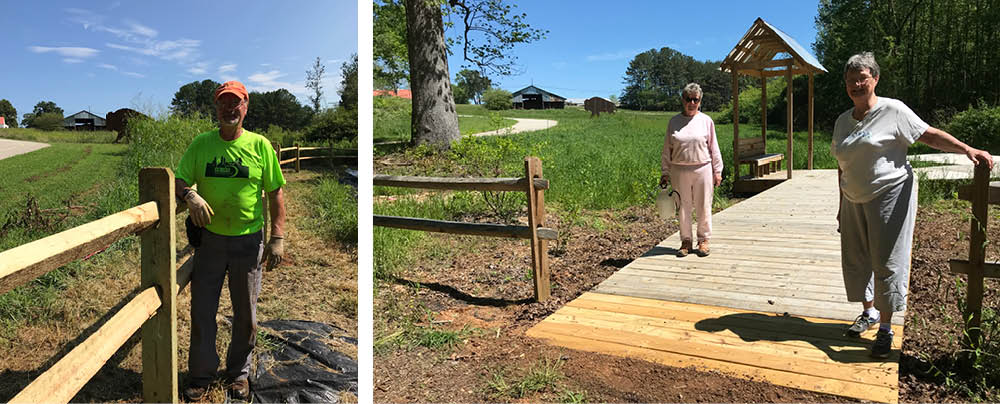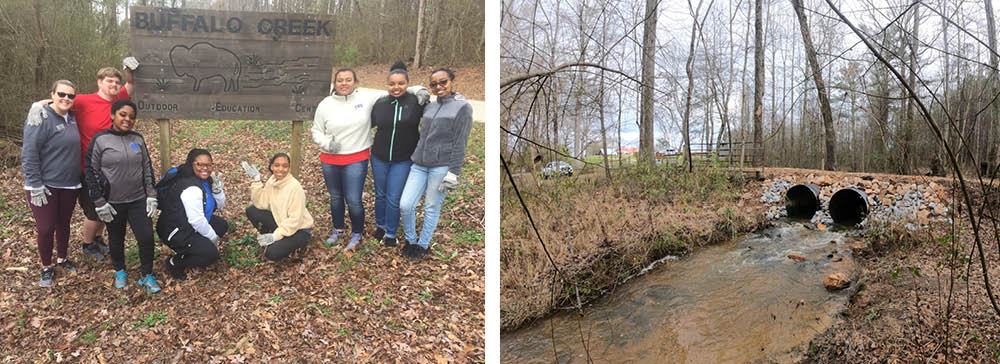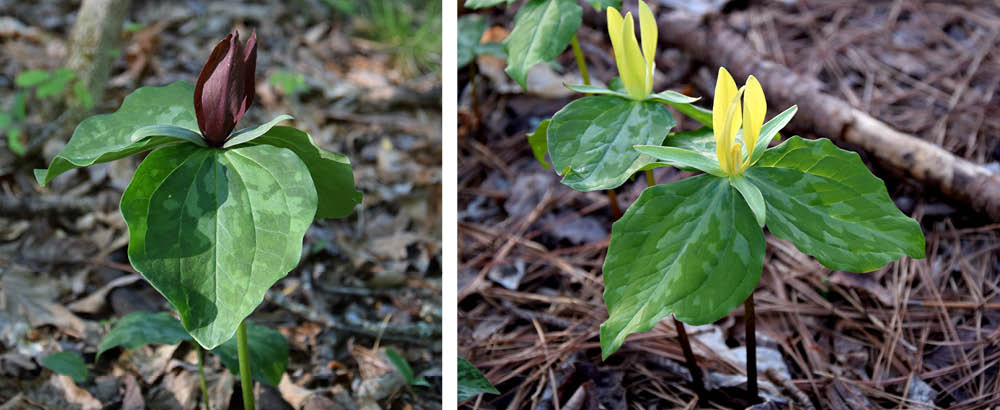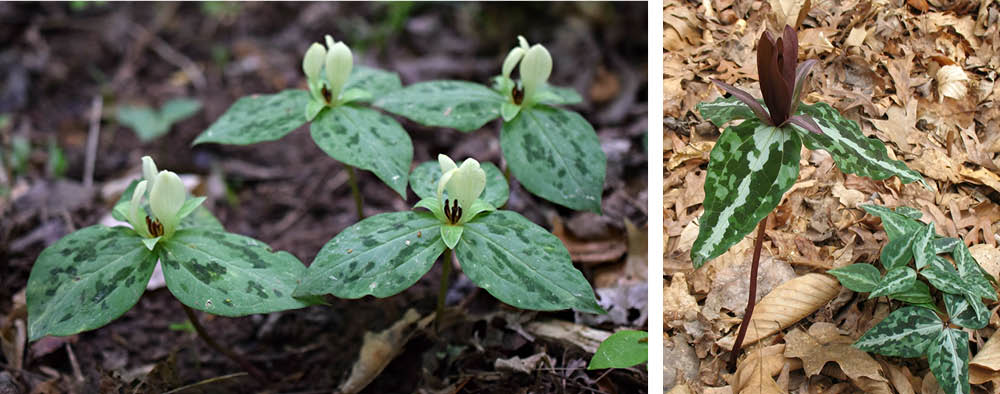From the State Board: Restoration Resources
Natural sites often fall victim to encroachment by non-native plants, some of which can be terribly invasive. Roadside views of these sites offer a window into a survival-of-the-fittest contest, where privet, English ivy, and — more recently — thorny Elaeagnus overtake native saplings, shrubs, and perennials. I don’t blame the average person for thinking that what they perceive to be natural/native plants are something to be avoided. Restoration efforts seem to be on the rise, thankfully, as groups of interested residents initiate efforts to protect (and beautify) their local natural areas in neighborhoods and parks.
GNPS efforts at restoration go back to one of our earliest partnerships—with Keep Cobb Beautiful at Heritage Park in Smyrna. Since then, GNPS members have increased the number of our restoration sites. An upcoming meeting on March 10th will focus on the topic of restoration. Several Atlanta members have put together this meeting to help showcase some local successes inside the Perimeter.
While much restoration work focuses on the removal of invasive plants, it also helps to know what should naturally be there and what folks might use if replacement plants are warranted. We recently learned of a resource that might help: a set of guides that provide an overview of commercially available native plants in the Georgia eastern piedmont. Through a partnership with the Athens-Clarke County Office of Sustainability and the State Botanical Garden of Georgia, these guides were created for use by both homeowners and industry professionals.
The six guides were compiled by Linda Chafin, Conservation Botanist at the State Botanical Garden, a longtime resource in Georgia for native plants and education. The set of guides includes information for uplands, woodlands, floodplains, and lowlands. The guides are available as downloadable and printable PDF files and can be found at this site.
If you’re interested in restoration, we’d welcome you at one of our existing sites or would be glad to help you find the resources to start your own community project. Watching a plant community to return to its natural form — nourishing the local insects and birds — is a very rewarding experience. Email us at restoration@gnps.org.
Chapter Meetings Coming Up
March is a busy month! We have four meetings coming up: one on Tuesday, March 10th in Gainesville; another on March 10th in Atlanta; one in south Georgia on March 18th following the South Georgia Native Plant and Wildflower Symposium in Tifton; and a fourth on Sunday, March 29th in Dunwoody. Join us if you’re near any of those. Several State Board members met with about 25 interested folks in Macon this past weekend; we hope to get a chapter forming there. If you weren’t there, shoot us an email at chapters@gnps.org to stay in the loop with that effort. Going local is our goal this year!
And as always, if you have questions or would like to reach us about other matters, send email to board@gnps.org.
Top photo: Bloodroot (Sanguinaria canadensis) and rue anenome (Thalictrum thalictroides), early bloomers you can find now nearby.
Chapter News: West Georgia
Carol Hight

Left: Reggie Jarrell stands by the split rail fence that he and Frank Bennett installed to deter mowing of planted areas along the Buffalo Creek Trail. Right: Flo Hayes and Carol Hight stand on boardwalk with the new ramp that brings ADA compliance to the trail.
With all the rain, workdays for the beginning of the year have been few and far between. But that doesn’t mean that the West Georgia Chapter folks have been taking it easy. At a January meeting of the Buffalo Creek Trail committee, a workday schedule was plotted out for the first four months of the year. Plans were laid to return to the Azalea Walk trail to add more azaleas, to mark the paths more clearly, and to upgrade the bridge and steps that lead into the Azalea area.
Stone steps were installed at the entrance to the Azalea Walk, replacing the old, and somewhat unsafe, wooden steps. Our metal artist is busily working on a set of decorative metal railings to add to the safety of the steps. The bridge across a dry creek bed has declined to the point of being unstable. It will be replaced with a sturdy wooden bridge with decorative wrought iron rails. Forty azaleas of several varieites have been purchased to add to those that were planted several years ago. In addition, a colony of red buckeyes will be planted near the entrance, with a colony of white buckeyes farther along the trail.
Another section of split rail fence was installed to prevent overly enthusiastic maintenance crews from mowing our newly installed flower beds. A ramp was added to the boardwalk, making it ADA compliant. Both of these projects were funded by grants.
Tree specialist Jonathan Stober walked the trail with several members, making recommendations about controlled burns in areas to be developed, as well as pointing out trees that need to be cut down and removed from some areas. He will follow up by mapping out each section we walked so that we will have a plan to work from on our workdays. The Univeristy of West Georgia is training students for participating in controlled burns and these volunteers will be part of the crew working with us. Our workday after Jonathan’s visit saw several members working to start removing some of the huge privet plants and some Kudzu vines.

Damage to the roof of the Boy Scout Hut has motivated its upcoming conversion to a covered pavilion.
Due to some severe winds in January, we have some damage to some of the buildings on the trail, including a camping building used by the Boy Scouts. The tin roof was blown off and will need to be replaced. There will be a complete remodel of the building, removing the torn screen wire and some wooden siding. It will become an open air, covered pavillion for meetings, picnics, speakers and use by the public. We have a carpenter who will begin on the upgrades to the Boy Scout Hut and installing the bridge over the dry creek so that additional trails can be connected to the Azalea Walk. Grant money will provide funding for these projects.
In January, a group of very enthusiastic University of West Georgia students did several hours of volunteer work on the trail, learning to recognize privet and invasive honeysuckle. They spent much of their time pulling the honeysuckle and privet (also learning to use the privet pullers). Some of them cleared deadfall from the woods that will be control burned, and placing these logs along the trail to more closely mark the trail boundaries. They were excited to learn about some of the native ferns that we found on the trail and we were able to provide more information about native plant identification and the importance of native plants in the environment.

Left: Volunteers from the University of West Georgia helped with invasive removal and trail improvements in January. Right: New drainage pipes will prevent trail erosion.
The county installed new drainage pipes underneath the trail to divert water that was eroding the trail surface. Underneath the access road from the meadow to the trails, the county also installed new pipes to replace some that were beginning to crumble. Beacuse of the degraded pipes, trees and debris were catching inside the pipes causing the water to back up and flood the trail upstream. Even with all the rain we’ve had this winter, we have avoided floods due to this upgrade.
Coming up
Grant money was used to purchase two new benches which will be installed along the trail at the next workday. We will be moving quite a few plants up the hill from the boardwalk area, as the drain pipe installed underneath the Greenbelt walking trail has funneled water into the area, turning it into a true bog that will be planted with new bog plants.
Our February meeting was the most well-attended we’ve ever had, with over 100 people in attendance. Mark Warren presented a fascinating program about the ways native Americans used trees, shrubs and forbs for medicine, food, tools, and fire.
We will host session four of a four-part class on seed propagation in March. Our presenter in February was Elaine Nash who has worked at the Stone Mountain Plant Propagation Project for many years. She provided great information about the kind of soil best used for seed starting, specifics on germination requirements of partiular seeds, and how to make our own ‘mini greenhouses’ with plastic jugs. The last session will be held in March, with participants planting seeds provided by the WGC.
Plant Spotlight: Trilliums, Part 1 — the Early Ones
Ellen Honeycutt

Left: Trillium cuneatum. Right: Trillium luteum.
Georgia holds a special honor when it comes to trilliums: Georgia has more indigenous species than any other state –22 species as of 2010 with more actively being evaluated for species level. Trilliums are fairly uncommon plants in general and are much cherished by native plant lovers. In undisturbed places there can be thousands of individual plants. However, most of us have a chance to see only a few here and there. I found 3 on our new property in 2003. Over the last 17 years, a few more have popped up, no doubt from seed sown long ago. It takes at least 7 years for a seed to become a flowering plant.
Trilliums are so named because so many of the parts come in “threes”: 3 leaves, 3 sepals, and 3 petals--all of which are visible to even the most novice of observers. The plants grow from underground rhizomes that gradually increase in size each year. Trilliums are “ephemeral” plants, usually fading in the hot weather and then remaining dormant until spring. Seeds form in fruit structures called “berries”; each of the small brown seeds is attached to a creamed-colored eliasome which is attractive to ants. Ants gather these seeds so that they can eat the nutritious eliasome, helping to disperse the seeds in the process.
One of the best experts on Georgia trilliums was Tom Patrick with GADNR (Georgia Department of Natural Resources). He spoke to our native plant society in 2010 and provided a wonderful handout. Most of this information is pulled from that resource.
Tom’s handout divides them into two groups: the Wakerobins and the Toadshades. These two groups are distinctly different in appearance so this separation makes sense. He has further divisions within those two groups; if you want more information, please use the link above to read further as he deserves all the credit for that work.
This month, I want to share information and photos for the Toadshades, known generally as the sessile group. They are the earliest to appear and flower in both north and south Georgia. Next month I’ll cover the Wakerobins. Tom described the Toadshades as “Trilliums with attractively mottled leaves; flowers sessile (no distinct flower stalk, the flower sitting directly on top of the leaves).”

Left: Trillium discolor. Right: Trillium decipiens.
The species in this group include: Trillium cuneatum, T. decipiens, T. delicatum (newly described in 2019), T. decumbens, T. discolor, T. lancifolium, T. ludovicianum (a GA NW population that Tom referenced, now considered T. freemanii), T. luteum, T. maculatum, T. reliquum, and T. underwoodii.
Trillium cuneatum is by far the most common and widespread of the toadshade trilliums - even more so than indicated by the USDA and BONAP maps as my county's populations are not represented. Often called Sweet Betsy, this species was our plant of the year in 2017. There is quite a bit of variance in color forms in the species - most petals are deep burgundy but some can be almost green. Even the sepals can vary from green to burgundy. Occasionally, individuals with multiple leaves have been found - I've seen as many as 12 leaves on a single plant. The degree of mottling is also variable; I have seen leaves that are almost entirely silver, with very few spots. In very NW Georgia, T. freemanii is similar in appearance but has an unpleasant odor.
Trillium discolor and Trillium luteum may both seem to resemble green forms of T. cuneatum, but they have distinct features that separate them. I love the unique lemon-y fragrance of T. luteum which is usually found in in rich mature forests on calcareous substrates. T. discolor can also be distinguished in the wild by where it is found: in the Savannah River drainage basin near Toccoa.

Left: Trillium maculatum. Right: Trillium underwoodii.
While some species are uniquely northern, others are uniquely elsewhere. Long before those of us north of Atlanta find the earliest blooming Trilllium cuneatum, southern residents are enjoying not only that species but also the blooms of Trillium maculatum and T. underwoodii. In mid-Georgia, one can also find Trillium decipiens and T. reliquum. Note: These are general locations, based on BONAP data.
Other mottled trilliums that are fairly unique in their appearance are Trillium decumbens and T. delicatum—both of which appear to sit flat on the ground but are found in different environments; and T. lancifolium—a petite and slender species, often in colonies.
So if you find one of our mottled trilliums, you might want to dive into the details of where it is located as well as some of the finer points of its appearance before you decide exactly which species it is. Or feel free just to enjoy these special Georgia plants just for being there. Georgia plants are what make Georgia be uniquely Georgia.

Left: Trillium decumbens. Right: Trillium lancifolium.
Volunteer for the Spring Plant Sale
Sheri George and Ellen Honeycutt
Our Spring Plant Sale on April 18th is fast approaching and we hope you’re getting as excited as we are to add more native plants to your garden. More and more people are learning about the importance of using native plants in their landscape to support pollinators, bees, and birds. We expect a good crowd at the sale – and could really use your help!
We need help on set-up day (April 17) and sale day (April 18) but for those of you who can’t make it, we could use your help on other days and in other ways, including Thursday, April 16. You do not need to be a plant expert, and there are jobs for everyone so fill out the volunteer form now and be a part of our biggest event of the year.
Volunteering is a great way to network and learn. It’s also a lot of fun. Your efforts contribute to the largest GNPS fundraising event of the year while also sharing the love of native plants, knowledge, friendship, and fellowship with others from the Society and potential new members. Please join us.
Direct link to registration: https://gnps.z2systems.com/np/clients/gnps/event.jsp?event=127&
If you'd like donate plants from your garden, here are some of the plants we could use: Green n gold (Chrysogonum virginianum), Heartleaf ginger (Hexastylis arifolia), Mouse-eared coreopsis (Coreopsis auriculata), Pussytoes (Antennaria), dwarf iris (Iris verna), Beebalm/wild bergamot (Monarda), Rue anemone (Thalictrum thalictroides), Trillium, Bloodroot (Sanguinaria canadensis), Ironweed (Vernonia), Bird’s foot violet (Viola pedata), wild bleeding heart (Dicentra eximia), Mayapple (Podophyllum peltatum), Toothwort (Cardamine), Smooth hydrangea (Hydrangea arborescens), Mapleleaf viburnum (Viburnum acerifolium), American beech saplings (Fagus grandifolia), Bigleaf magnolia (Magnolia macrophylla or M. tripetala), Musclewood (Carpinus caroliniana) and native ferns. Please pot them up and we'll advise where you can bring donations as the time gets a little close to the April 18th sale date. Email us at springplantsale@gnps.org if you have any questions.
|